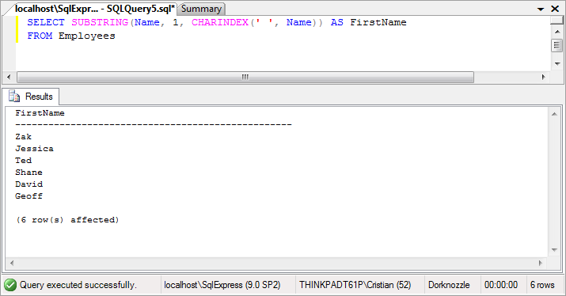Build Your Own ASP.NET 3.5 Website Using C# & VB (60 page)
Read Build Your Own ASP.NET 3.5 Website Using C# & VB Online
Authors: Cristian Darie,Zak Ruvalcaba,Wyatt Barnett
Tags: #C♯ (Computer program language), #Active server pages, #Programming Languages, #C#, #Web Page Design, #Computers, #Web site development, #internet programming, #General, #C? (Computer program language), #Internet, #Visual BASIC, #Microsoft Visual BASIC, #Application Development, #Microsoft .NET Framework

>
The greater-than operator is used in WHERE clauses to determine whether
the first value is greater than the second. For example, the following query
would return all the records from the table whose EmployeeID is greater
than ten (that is, 11 and up):
FROM Employees
WHERE EmployeeID > 10
<
The less-than operator is used in WHERE clauses to determine whether the
first value is less than the second. The result of the following query would
return from the table all records whose EmployeeID is less than ten (that
is, nine and lower):
FROM Employees
WHERE EmployeeID < 10
>=
The greater-than or equal-to operator is used in WHERE clauses to determine
whether the first value is greater than, or equal to, the second. The following query would return the record with an EmployeeID of ten, and every one after that:
FROM Employees
WHERE EmployeeID >= 10
Licensed to [email protected]
Speaking SQL
327
<=
The less-than or equal-to operator is used in WHERE clauses to determine
whether the first value is less than, or equal to, the second. The result of
the following query would be the record with EmployeeID of ten, and
every one before that:
FROM Employees
WHERE EmployeeID <= 10
<>, !=
This operator is used to check whether a value is not equal to a second.
OR
This operator is used with the WHERE clause in the SELECT statement. The
OR operator can be used when a certain condition needs to be met, or
when only one of two conditions needs to be met. For example, the following query’s results would return the employees with employee IDs of 1 or 2:
FROM Employees
WHERE EmployeeID = 1 OR EmployeeID = 2
AND
This operator works just like OR, except that it requires
all
of the conditions
to be satisfied, not just any of them.
NOT
Typically used in conjunction with the LIKE operator, the NOT operator
is used when we’re looking for values that are not like the value we specify. For example, the following query would return all employees whose names do not begin with “Jess:”
FROM Employees
WHERE Name NOT LIKE 'Jess%'
_, ?
The underscore operator is used by SQL Server in WHERE clauses, and
matches any single character in a string. For instance, if you weren’t sure
of the first letter of Geoff Kim’s surname, you could use the following
query:
Licensed to [email protected]


328
Build Your Own ASP.NET 3.5 Web Site Using C# & VB
FROM Employees
WHERE Name LIKE 'Geoff _im'
This would return Geoff Kim’s record, as well as Geoff Sim’s, Geoff Lim’s,
and so on, were there such employees in the database. Note that the _
character only matches a single character, so Geoff Sirrim would not be
returned. To match zero or more characters, you’d use the % or * operator.
%, *
The multiple character operator is similar to the underscore operator,
except that it matches multiple or zero characters, whereas the underscore
operator only matches one.
IN
This operator is used in WHERE clauses to specify that an expression’s
value must be one of the values specified in a list.
Transact-SQL Functions
As well as using operators to construct expressions manually, SQL Server provides
us with some functions that we can use within our queries. For the most part, SQL
has sufficient functions to handle almost all of the day-to-day tasks that you’ll undertake. So let’s take a look at some of the most useful and common functions you’re likely to use in your queries.
Getting More Information
Note that the complete list of built-in functions supported by T-SQL is much
longer than that presented here; you can find the complete lists by searching for,
say, “string functions” or “date and time functions” in the free SQL Server documentation, SQL Server Books Online, which can be downloaded from
Microsoft’s
TechNet site.
1 Additionally, SQL Server allows you to create your own userdefined functions either in SQL, or a language such as VB or C#. However, this is an advanced topic that we won’t be covering in this book.
1 http://www.microsoft.com/technet/prodtechnol/sql/2005/downloads/books.mspx
Licensed to [email protected]
Speaking SQL
329
Arithmetic Functions
SQL supports many arithmetic functions. Although the commonly preferred solution
is to perform such calculations in VB or C# code, SQL’s arithmetic functions can
prove handy at times.
ABS
This function returns the absolute value. Both of the following queries will return
the value 5:
SELECT ABS(5)
SELECT ABS(-5)
CEILING
CEILING returns the smallest integer that’s greater than the value that was passed
in. In other words, this function rounds up the value passed in. The following
query will return 6:
SELECT CEILING(5.5)
FLOOR
This function returns the largest integer that’s less than the value that was passed
in; in other words, it rounds down the value that was passed in. The following
query will return the value 5:
SELECT FLOOR(5.5)
MOD
MOD returns the remainder of one value divided by another. The following query
would return the value 2:
SELECT MOD(8, 3)
SIGN
This function returns -1, 0, or 1, to indicate the sign of the argument.
Licensed to [email protected]
330
Build Your Own ASP.NET 3.5 Web Site Using C# & VB
POWER
This function returns the result of one value raised to the power of another. The
following query returns the result of 23:
SELECT POWER(2, 3)
SQRT
SQRT returns the non-negative square root of a value.
Many, many more mathematical functions are available—check SQL Server Books
Online for a full list.
String Functions
String functions work with literal text values rather than numeric values.
UPPER, LOWER
This function returns the value passed in as all uppercase or all lowercase, respectively. Take the following query as an example: SELECT LOWER(Username), UPPER(State)
The query above will return a list of usernames in lowercase, and a list of states
in uppercase.
LTRIM, RTRIM
This function trims whitespace characters, such as spaces, from the left-or righthand side of the string, respectively.
REPLACE
Use the REPLACE function to change a portion of a string to a new sequence of
characters that you specify:
SELECT REPLACE('I like chocolate', 'like', 'love')
This query will search the string “I like chocolate” for the word “like” and replace it with the word “love,” as shown in the output below: Licensed to [email protected]
Speaking SQL
331
-----------------------------------------------------I love chocolate
(1 row(s) affected)
SUBSTRING
This function returns the sequence of characters within a given value, beginning
at a specified start position and spanning a specified number of characters:
SELECT SUBSTRING('I like chocolate', 8, 4)
The above query will take four characters from the string “I like chocolate”
starting from the eighth character, as shown in the output below:
---choc
(1 row(s) affected)
LEN
This function returns the length of a string. Thus, the following query would
return a list of all usernames, and how many characters were in each username:
SELECT Username, LEN(Username) AS UsernameLength
CHARINDEX
This function returns the first position in which a substring can be found in a
string.
It’s also worth noting that these functions can be used in conjunction with other
functions, often to create quite powerful results. For example, the following SQL
query would return the first name of every employee within the Employees table:
SELECT SUBSTRING(Name, 1, CHARINDEX(' ', Name)) AS FirstName
Here, we’re using two string functions. CHARINDEX is used to locate the first space
within the Name column. If we assume that the first space indicates the end of the
Licensed to [email protected]

332
Build Your Own ASP.NET 3.5 Web Site Using C# & VB
first name, we can then use SUBSTRING to extract the first name from the name string.
The results, shown in
Figure 8.9
, are as we’d expect.
Figure 8.9. Employees’ first names
Note that the query isn’t bulletproof—it’s only suitable for western-style names. If
an employee had no spaces in his or her name (imagine, for instance, that we hired
Cher to work as an Engineer), then the CHARINDEX function would return -1, indicating that there was no space character in the name. The SUBSTRING function would then return NULL, so the list of results would be flawed.
Date and Time Functions
Date and time functions facilitate the manipulation of dates and times that are stored
within your database. These functions work with arguments of the datetime type.
Here are some of the most useful ones:
GETDATE
returns the current date and time
DATEADD
adds an interval to an existing date (a number of days, weeks, etc.) in order to
obtain a new date
DATEDIFF
calculates the difference between two specified dates
Licensed to [email protected]
Speaking SQL
333
DATEPART
returns a part of a date (such as the day, month, or year)
DAY
returns the day number from a date
MONTH
returns the month number from a date
YEAR
returns the year from a date
We won’t be working with these functions in our example application, but it’s good
to keep them in mind. Here’s a quick example that displays the current year:
SELECT YEAR(GETDATE())
The result (assuming it’s still 2008, of course) is shown below:
CurrentYear
----------2008
(1 row(s) affected)
Working with Groups of Values
Transact-SQL includes two very useful clauses that handle the grouping of records,
